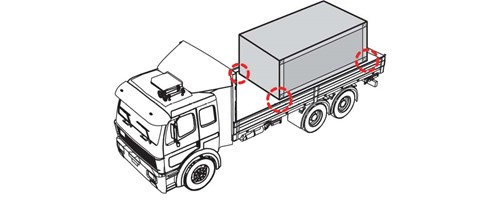
What Does This Section Cover? (Section 3.6.1)
The requirements in this section apply to the transportation of all intermodal containers.
Note: When securing cargo contained within an intermodal container, follow general cargo securement requirements (Section 2) or, if applicable, follow the commodity specific requirements.
Special Circumstances: Securing Loaded Intermodal Containers on Container Chassis Vehicles (Section 3.6.2)
Requirements for securing the container
Secure each intermodal container to the container chassis with securement or integral locking devices that cannot accidentally become unfastened. Integral locking devices do not have to be adjustable.

Integral Locking Device
Note: If necessary, use secondary attachments to ensure that latches remain fastened in transit.
Securing devices must restrain the container from moving more than:
- 1.27 cm (1/2 in) forward.
- 1.27 cm (1/2 in) rearward.
- 1.27 cm (1/2 in) to the right.
- 1.27 cm (1/2 in) to the left.2.54 cm (1 in) vertically.
Secure the front and rear of the container independently.
- 2 latches on the chassis engage anchor points towards or at the front of the container.
- 2 latches on the chassis engage anchor points towards or at the rear of the container.
If a latch is missing or broken, secure the corner by an alternative means, such as:
- Chain.
- Wire rope.
Special Circumstances: Securing Loaded Intermodal Containers on Non-Chassis Vehicles (Section 3.6.3)
Requirements for positioning the container
- Position the intermodal container so that:
- Either all lower corners rest upon the vehicle.
- Or the corners are supported by a structure capable of bearing the weight of the container. Independently secure the support structure to the vehicle.

All four corners are resting upon the vehicle
Requirements for securing the container
- Secure each container to the vehicle by:
- Either chains, wire ropes, or integral devices that are fixed to all lower corners.
- Or crossed chains that are fixed to all upper corners.
- Or both.
- Secure the front and rear of the loaded container independently.
- Secure the four corners using tiedowns that are attached to the loaded container.
- The tiedowns must have an aggregate working load limit of at least 50% of the loaded weight of the loaded container.
- Attach each chain, wire rope, or integral locking device to the container in a manner that prevents it from becoming unfastened while in transit.
Special Circumstances: Securing Empty Intermodal Containers on Non-Chassis Vehicles (Section 3.6.4)
Empty intermodal containers transported on non-chassis vehicles do not have to have all lower corners resting upon the vehicle or supported by a structure if they meet each of the following four requirements:
- Requirement 1: The container is balanced and positioned on the vehicle so it is stable before adding tiedowns or other securing devices.
- Requirement 2: The container does not hang over the front or rear of the trailer by more than 1.5 m (5 ft).
- Requirement 3: The container does not interfere with the vehicles maneuverability.
- Requirement 4: The container is secured to prevent side-to-side, forward, rearward, and upward movement by:
- Either by following the requirements for loaded containers.
- Or by following the general cargo securement requirements (Section 2) for tiedowns.


